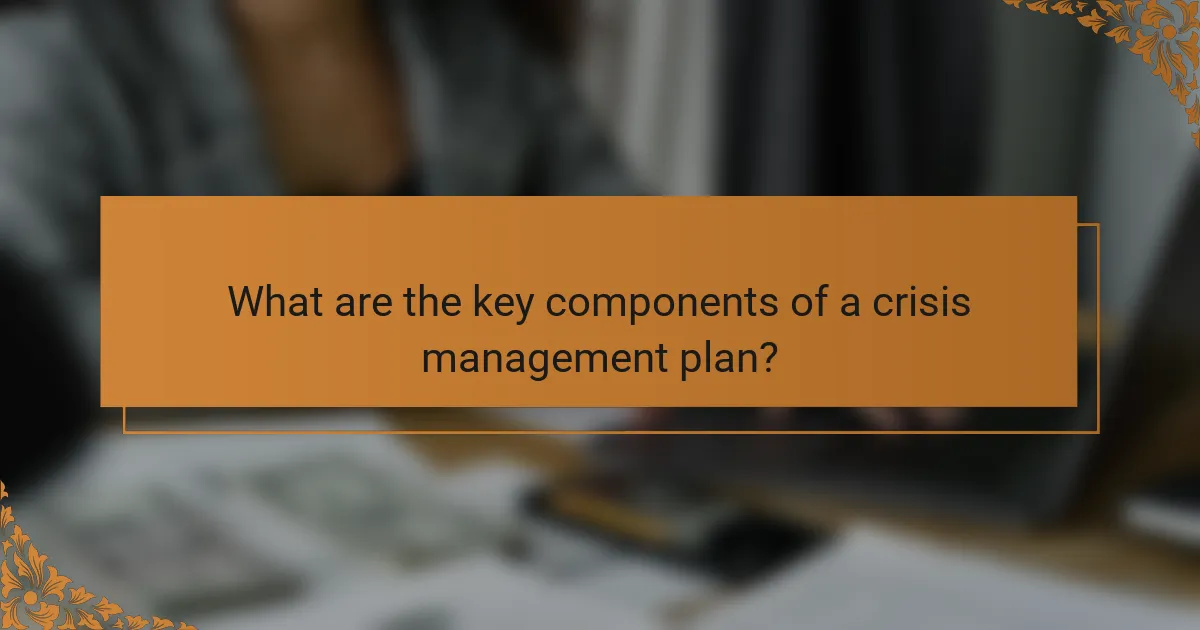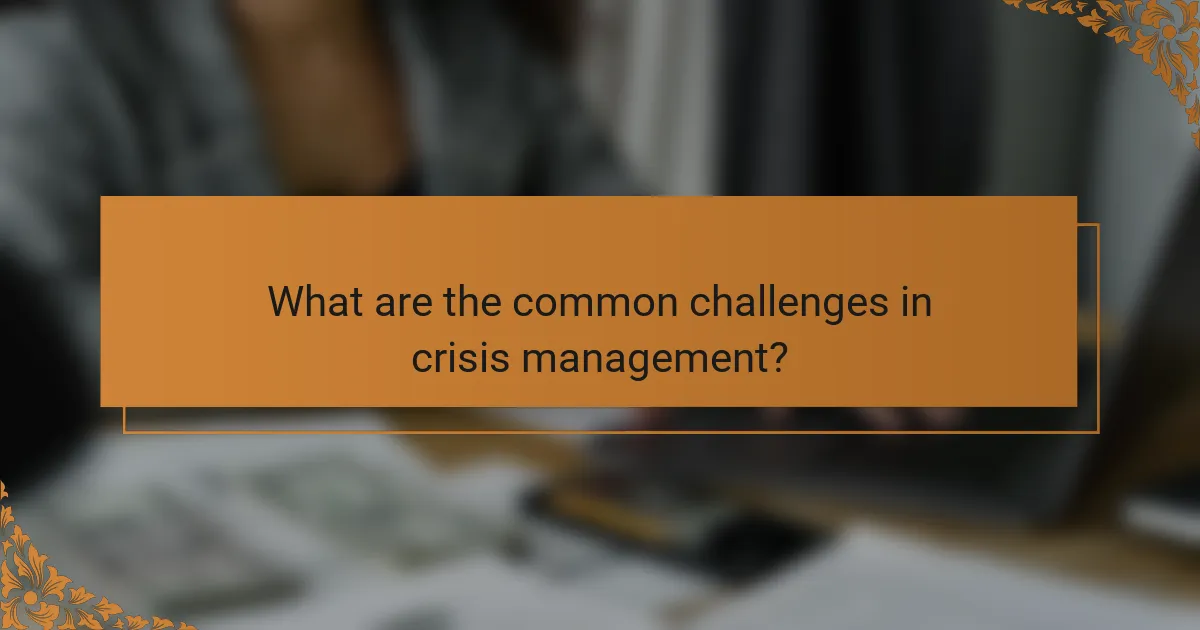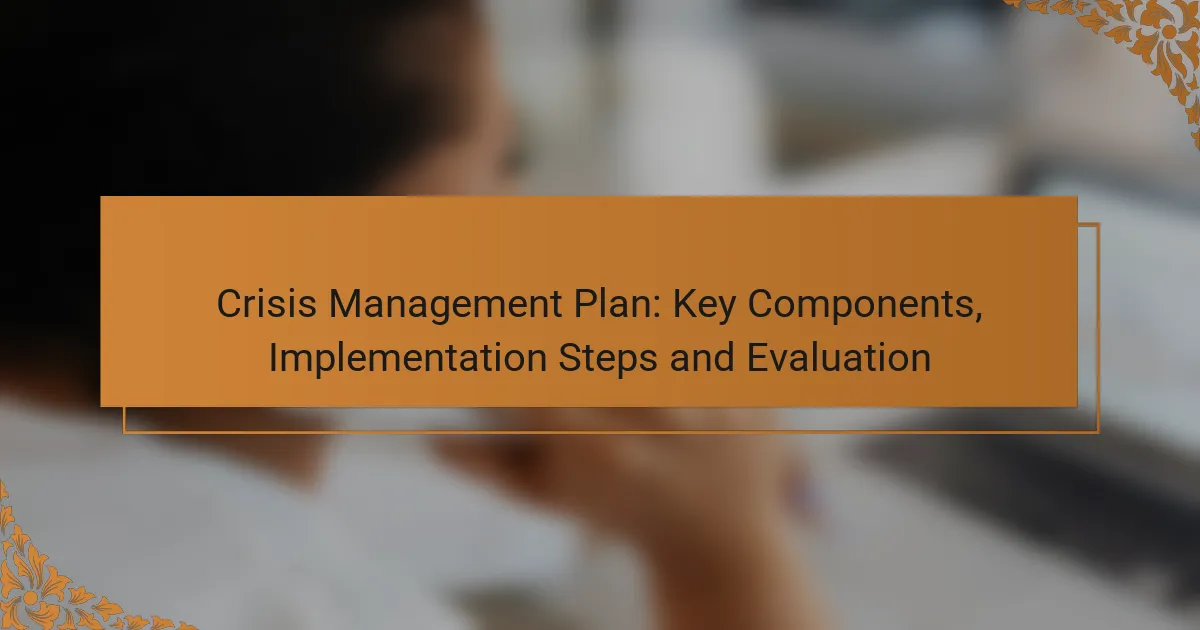A crisis management plan is vital for organizations to navigate unexpected events with resilience and efficiency. It encompasses key components such as risk assessment, communication strategies, and recovery procedures, all aimed at minimizing impact and ensuring swift recovery. The implementation process involves forming dedicated teams, training staff, and conducting simulations to test the plan’s effectiveness. Regular evaluation further enhances preparedness by identifying areas for improvement based on past experiences.

What are the key components of a crisis management plan?
A crisis management plan is essential for organizations to effectively prepare for, respond to, and recover from unexpected events. Key components include risk assessment, communication strategy, response team structure, recovery procedures, and training and drills.
Risk assessment
Risk assessment involves identifying potential threats and vulnerabilities that could impact the organization. This process helps prioritize risks based on their likelihood and potential impact, allowing for focused planning.
Consider using a risk matrix to categorize risks as low, medium, or high. Regularly review and update the assessment to reflect changes in the operational environment or emerging threats.
Communication strategy
A robust communication strategy ensures timely and accurate information dissemination during a crisis. This includes establishing clear channels for internal and external communication, as well as identifying key messages for stakeholders.
Utilize multiple platforms, such as email, social media, and press releases, to reach diverse audiences. Regularly test the strategy to ensure effectiveness and clarity in messaging during an actual crisis.
Response team structure
The response team structure defines roles and responsibilities during a crisis. This team typically includes members from various departments, ensuring a comprehensive approach to crisis management.
Clearly outline each member’s duties and establish a chain of command. Regularly review and update the structure to accommodate personnel changes or shifts in organizational priorities.
Recovery procedures
Recovery procedures focus on restoring normal operations after a crisis. This includes assessing damage, implementing corrective actions, and communicating recovery plans to stakeholders.
Develop a step-by-step recovery plan that addresses key areas such as financial implications, resource allocation, and timeline for resuming operations. Ensure that the plan is flexible to adapt to varying circumstances.
Training and drills
Training and drills are critical for ensuring that all team members are familiar with the crisis management plan. Regular practice helps identify gaps in the plan and improves overall response effectiveness.
Conduct drills at least annually, incorporating different scenarios to test various aspects of the plan. Encourage feedback from participants to refine processes and enhance preparedness for real-life situations.

How to implement a crisis management plan in the UK?
Implementing a crisis management plan in the UK involves a structured approach that includes forming a dedicated team, training staff, establishing communication protocols, and testing the plan through simulations. These steps ensure that organizations can respond effectively to crises while minimizing impact and maintaining compliance with local regulations.
Establish a crisis management team
The first step in implementing a crisis management plan is to establish a crisis management team. This team should include representatives from various departments such as operations, communications, legal, and human resources to ensure comprehensive coverage of all aspects of a crisis.
Assign clear roles and responsibilities within the team to streamline decision-making during a crisis. Regular meetings should be held to review and update the plan, ensuring that all members are familiar with their duties and the overall strategy.
Conduct training sessions
Training sessions are essential for preparing your team to handle crises effectively. These sessions should cover the crisis management plan in detail, including specific scenarios that the organization may face.
Consider using a mix of training methods, such as workshops, online courses, and role-playing exercises. Regularly scheduled training helps keep skills sharp and ensures that all staff members understand their roles in a crisis situation.
Develop communication protocols
Effective communication is critical during a crisis. Developing clear communication protocols ensures that information flows smoothly between team members, stakeholders, and the public. Establish guidelines for internal and external communication, specifying who communicates what and when.
Utilize multiple channels for communication, including social media, email, and press releases, to reach a wider audience. Ensure that all communications are consistent and align with the organization’s values and messaging.
Test the plan with simulations
Testing the crisis management plan through simulations is vital to identify gaps and improve response strategies. Conduct regular drills that mimic potential crisis scenarios, allowing the team to practice their roles and refine their processes.
After each simulation, hold a debriefing session to discuss what worked well and what needs improvement. This feedback loop is crucial for enhancing the plan and ensuring that the team is prepared for real-life crises.

What are the steps to evaluate a crisis management plan?
Evaluating a crisis management plan involves assessing its effectiveness after a crisis has occurred. This process ensures that lessons are learned and improvements are made for future preparedness.
Post-crisis review
A post-crisis review is a thorough examination of the response to a crisis. This review should involve all key stakeholders and focus on what worked well and what did not. Gathering insights from various perspectives can provide a comprehensive understanding of the plan’s effectiveness.
During this review, consider documenting specific incidents, decisions made, and the overall outcome. This documentation will serve as a valuable reference for future evaluations and training sessions.
Feedback collection
Collecting feedback from team members, stakeholders, and affected parties is crucial for evaluating a crisis management plan. Use surveys or interviews to gather qualitative and quantitative data on their experiences and perceptions during the crisis.
Ensure that the feedback process is anonymous to encourage honest responses. This can reveal blind spots in the plan and highlight areas for improvement that may not be immediately apparent to leadership.
Performance metrics analysis
Analyzing performance metrics helps quantify the effectiveness of the crisis management plan. Key metrics may include response time, resource allocation, and stakeholder satisfaction levels. Establish benchmarks to compare performance against industry standards or previous crises.
Utilize both qualitative and quantitative data to create a balanced view of the plan’s performance. This analysis can identify trends and areas needing enhancement, guiding future revisions of the plan.
Plan updates and revisions
Based on the findings from the post-crisis review, feedback collection, and performance metrics analysis, update the crisis management plan accordingly. Revisions should address identified weaknesses and incorporate best practices learned from the evaluation process.
Regularly scheduled reviews and updates, ideally annually or after significant incidents, ensure the plan remains relevant and effective. Engage stakeholders in this process to foster a culture of continuous improvement and preparedness.

What are the common challenges in crisis management?
Crisis management often faces challenges such as resource constraints, ineffective communication, and maintaining team morale. Addressing these issues is crucial for a successful response and recovery during a crisis.
Resource allocation
Effective resource allocation is vital during a crisis, as it determines how well an organization can respond to immediate needs. Prioritizing resources based on urgency and impact can help in managing limited supplies and personnel effectively.
Consider creating a tiered system for resource distribution, where critical needs are met first. For instance, in a natural disaster, focus on essentials like food, water, and medical supplies before addressing less urgent needs.
Stakeholder communication
Clear and timely communication with stakeholders is essential during a crisis. This includes informing employees, customers, and partners about the situation and the organization’s response strategy.
Utilize multiple channels such as emails, social media, and press releases to ensure that messages reach all relevant parties. Regular updates can help manage expectations and reduce misinformation.
Maintaining team morale
Keeping team morale high during a crisis is crucial for maintaining productivity and cohesion. Acknowledging the stress and uncertainty faced by employees can foster a supportive environment.
Implement strategies such as regular check-ins, providing mental health resources, and encouraging open dialogue. Recognizing individual and team efforts can also boost morale and reinforce a sense of purpose amidst challenges.

How does technology enhance crisis management?
Technology significantly enhances crisis management by providing tools for rapid communication, data analysis, and resource allocation. These capabilities enable organizations to respond swiftly and effectively during emergencies, minimizing potential damage and ensuring public safety.
Real-time data analysis
Real-time data analysis allows organizations to monitor situations as they unfold, providing critical insights that inform decision-making. By leveraging data from various sources such as sensors, cameras, and social media, teams can identify trends and anomalies that may indicate a crisis.
Implementing data analytics tools can streamline the process of gathering and interpreting information. For example, using dashboards that visualize key metrics can help crisis managers quickly assess the severity of a situation and allocate resources accordingly. Organizations should consider investing in software that integrates multiple data sources for comprehensive analysis.
Social media monitoring
Social media monitoring is essential for understanding public sentiment and gathering real-time feedback during a crisis. By tracking mentions, hashtags, and trends, organizations can gauge how information is spreading and adjust their communication strategies to address misinformation or concerns.
Utilizing social media analytics tools can enhance this process by providing insights into audience engagement and sentiment analysis. Organizations should establish a protocol for responding to social media inquiries promptly, ensuring that accurate information is disseminated and public trust is maintained. Regularly reviewing social media metrics can also help refine crisis management strategies over time.
